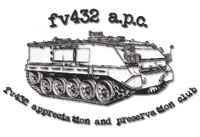
A bit about the fv432.
A brief history.
With the introduction into service of the first fv432 in 1963, the British Army received its first purpose built, fully tracked armoured personnel carrier. It was designed to replace the Saracen 6x6 wheeled APC, and by extension the Humber ‘Pig’ 4x4 wheeled APC. These two vehicles, however, remained in service in the internal security role. Around 3000 of the fv432 family were built and many remain in service to date (2011), although more in supporting roles with the advent of more up to date designs such as the Warrior and CVR (T) series.
Unlike its direct contemporary the American M113, the fv432 is of all steel construction, which would arguably give better protection against small arms fire. The basic version comes with a single machine gun mounted on the commander’s cupola, but turreted variants with machine gun and 30mm Rarden cannon armament have appeared together with many variants. These include ambulance, mortar carrier and command variants. A maintenance variant, crane equipped, is designated fv434.
This fully enclosed vehicle usually carries a crew of two, driver and commander/gunner, and ten troops, who sit at the rear of the vehicle on seats which tip back against the hull sides to give a large (3670 kg) load carrying capability when required.
Construction.
As mentioned, the hull is of all-welded steel construction. The driver is situated at the front of the vehicle on the right hand side, with a single piece hatch opening to the left. The commander sits behind under a 360-degree cupola, to which the machine gun is fixed. Behind the commander's position, also in the roof, is a large circular hatch over the troop compartment. On the vehicles fitted with a turret this is the site it occupies. Under the hatch the troops sit five each side, facing inwards. The troops leave the vehicle via a large door in the rear panel that opens to the right. The engine compartment is to the left of the driver with drive to the front sprockets via a semi-automatic transmission. The exhaust goes down the left of the vehicle and the NBC (Nuclear Biological Chemical) system down the right. There are five double road wheels on each side on torsion bars with idlers at the rear, and two return rollers on each side.
Power Plant.
Originally the mk1 was fitted with the Rolls Royce B81 Petrol engine. With the introduction of the mk2 and mk2/1, the pack was replaced with the Rolls Royce K60 diesel-multifuel engine. Both engines transmitted drive to the steering box via the Allinson semi-automatic gearbox.
In 2006 the fv432 family went through a major refit. Due to health and safety concerns, the whole power plant and transmission was replaced as steering and braking systems were one of the same. To overcome this the MOD have fitted separate braking and steering systems, now powered by the Cummins 6BTA engine.
Equipment Fit.
The vehicle was amphibious with a small amount of preparation, but this facility has been removed from surviving vehicles. The driver has an AFV No. 33 Mk.I wide-angle periscope, which can be replaced with a MEL L5AI passive periscope for night use. The commander's cupola has three AFV No. 32 Mk. I periscopes. A few vehicles were converted to take the turret of the Fox armoured car with a 30mm Rarden cannon. The NBC system provides fresh air to both drivers and troop compartments. The engine compartment is fitted with a Firewire detection system. Most vehicles if not all still in use, have had engine, steering and braking upgrades.
What was it used for?
The concept of an armoured personnel carrier goes back to the British Mk IX tank of 1917/1918. The idea fell into abeyance until 1942/1943 when half-track vehicles (Germany and United States) and some full track vehicles, such as converted tanks and universal carriers (Britain and Allied Nations) came into widespread use.
The advantages of fully tracked personnel carriers to act as ‘battle-taxis’ in fully integrated armoured formations were obvious, but it took until the early 1960s for such designs to become widespread. The concept has now gone further with armoured vehicles from which troops can fight whilst on the move.
Quick Data.
- Type: Armoured Personnel Carrier
- In service: 1963-Present (2011)
- Armament: 7.62mm machine gun
- Smoke protection: Two three-barrel smoke dischargers
- Fuel Capacity: 454 litres (120 gals)
- Speed: (on roads) 52.2km/h (32.5mph)
- Engine: Rolls Royce K60 No. 4 Mk 4F 2 stroke multi-fuel 240bhp at 3750 revs
- Width: 2.794m (9ft 2in)
- Length: 5.251m (17ft 2in)
- Height: 2.286m (7ft 6in)
- Weight: (combat)15380kg(15.5 tons)
- Crew: 2 and 10



